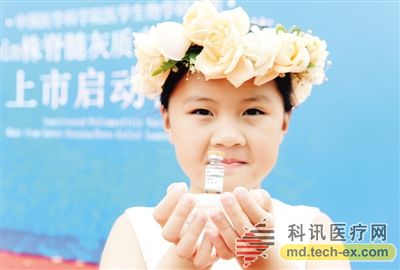China's independent research and development of Sabin strain polio inactivated vaccine
Release date: 2015-07-02

The children showed the inactivated vaccine against polio in the Sabin strain at the Institute of Medical Biology, Chinese Academy of Medical Sciences.
After nearly 30 years of scientific research, the self-developed Sabin strain polio inactivated vaccine (single seedling) was officially launched on June 30. The launch of the vaccine fills the gap in the field of polio inactivated vaccine production in China.
Polio, also known as poliomyelitis, is an acute infectious disease caused by type I, II, and III poliovirus infections. It occurs mostly in infants and young children and has been called "the biggest killer of children's life and health" by the medical community.
According to researchers, the Sabin strain polio inactivated vaccine (sIPV) is an innovative vaccine product independently developed by the Institute of Medical Biology of the Chinese Academy of Medical Sciences for nearly 30 years.
Currently, countries around the world mainly use polio inactivated vaccine (IPV) for injection and oral polio live attenuated vaccine (OPV) to prevent polio. China's prevention and control work began in the 1960s, and effectively promoted the occurrence of the disease by promoting oral polio attenuated live vaccines throughout the country.
Oral polio attenuated live vaccine, commonly known as "sugar pill", has good immune effect and low price, and is a type of vaccine listed in the national immunization program. However, because it is a live attenuated vaccine, it still has potential risk of disease. Although the imported polio inactivated vaccine for injection has been listed in China, the purchase price is very high. The successful launch of China's independent research and development of sIPV not only improved the safety of vaccination, but also broke the monopoly of polio inactivated vaccine production in developed countries.
According to reports, the first phase of the sIPV production line of the Institute of Medical Biology of the Chinese Academy of Medical Sciences is 15 million to 20 million doses per year, which can meet the needs of a national newborn IPV vaccination. The second phase of the production line is expected to be completed by the end of 2016, with a capacity of 60 million doses per year. After the project is put into production, it will meet the needs of IPV for the whole country.
Source: China Science and Technology Network - Technology Daily
Seeds,Palay Seeds,Hybrid Palay Seeds,Palay Seeds Variety
XIKE AGRICULTURAL GROUP CO . .LTD. , https://www.laoseed.com
